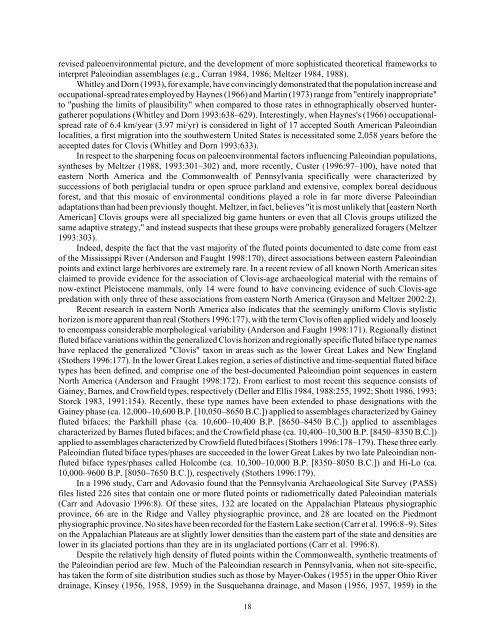Watershed Conservation Plan - Destination Erie
Watershed Conservation Plan - Destination Erie
Watershed Conservation Plan - Destination Erie
Create successful ePaper yourself
Turn your PDF publications into a flip-book with our unique Google optimized e-Paper software.
evised paleoenvironmental picture, and the development of more sophisticated theoretical frameworks to<br />
interpret Paleoindian assemblages (e.g., Curran 1984, 1986; Meltzer 1984, 1988).<br />
Whitley and Dorn (1993), for example, have convincingly demonstrated that the population increase and<br />
occupational-spread rates employed by Haynes (1966) and Martin (1973) range from "entirely inappropriate"<br />
to "pushing the limits of plausibility" when compared to those rates in ethnographically observed huntergatherer<br />
populations (Whitley and Dorn 1993:638–629). Interestingly, when Haynes's (1966) occupationalspread<br />
rate of 6.4 km/year (3.97 mi/yr) is considered in light of 17 accepted South American Paleoindian<br />
localities, a first migration into the southwestern United States is necessitated some 2,058 years before the<br />
accepted dates for Clovis (Whitley and Dorn 1993:633).<br />
In respect to the sharpening focus on paleoenvironmental factors influencing Paleoindian populations,<br />
syntheses by Meltzer (1988, 1993:301–302) and, more recently, Custer (1996:97–100), have noted that<br />
eastern North America and the Commonwealth of Pennsylvania specifically were characterized by<br />
successions of both periglacial tundra or open spruce parkland and extensive, complex boreal deciduous<br />
forest, and that this mosaic of environmental conditions played a role in far more diverse Paleoindian<br />
adaptations than had been previously thought. Meltzer, in fact, believes "it is most unlikely that [eastern North<br />
American] Clovis groups were all specialized big game hunters or even that all Clovis groups utilized the<br />
same adaptive strategy," and instead suspects that these groups were probably generalized foragers (Meltzer<br />
1993:303).<br />
Indeed, despite the fact that the vast majority of the fluted points documented to date come from east<br />
of the Mississippi River (Anderson and Faught 1998:170), direct associations between eastern Paleoindian<br />
points and extinct large herbivores are extremely rare. In a recent review of all known North American sites<br />
claimed to provide evidence for the association of Clovis-age archaeological material with the remains of<br />
now-extinct Pleistocene mammals, only 14 were found to have convincing evidence of such Clovis-age<br />
predation with only three of these associations from eastern North America (Grayson and Meltzer 2002:2).<br />
Recent research in eastern North America also indicates that the seemingly uniform Clovis stylistic<br />
horizon is more apparent than real (Stothers 1996:177), with the term Clovis often applied widely and loosely<br />
to encompass considerable morphological variability (Anderson and Faught 1998:171). Regionally distinct<br />
fluted biface variations within the generalized Clovis horizon and regionally specific fluted biface type names<br />
have replaced the generalized "Clovis" taxon in areas such as the lower Great Lakes and New England<br />
(Stothers 1996:177). In the lower Great Lakes region, a series of distinctive and time-sequential fluted biface<br />
types has been defined, and comprise one of the best-documented Paleoindian point sequences in eastern<br />
North America (Anderson and Fraught 1998:172). From earliest to most recent this sequence consists of<br />
Gainey, Barnes, and Crowfield types, respectively (Deller and Ellis 1984, 1988:255, 1992; Shott 1986, 1993;<br />
Storck 1983, 1991:154). Recently, these type names have been extended to phase designations with the<br />
Gainey phase (ca. 12,000–10,600 B.P. [10,050–8650 B.C.]) applied to assemblages characterized by Gainey<br />
fluted bifaces; the Parkhill phase (ca. 10,600–10,400 B.P. [8650–8450 B.C.]) applied to assemblages<br />
characterized by Barnes fluted bifaces; and the Crowfield phase (ca. 10,400–10,300 B.P. [8450–8350 B.C.])<br />
applied to assemblages characterized by Crowfield fluted bifaces (Stothers 1996:178–179). These three early<br />
Paleoindian fluted biface types/phases are succeeded in the lower Great Lakes by two late Paleoindian nonfluted<br />
biface types/phases called Holcombe (ca. 10,300–10,000 B.P. [8350–8050 B.C.]) and Hi-Lo (ca.<br />
10,000–9600 B.P. [8050–7650 B.C.]), respectively (Stothers 1996:179).<br />
In a 1996 study, Carr and Adovasio found that the Pennsylvania Archaeological Site Survey (PASS)<br />
files listed 226 sites that contain one or more fluted points or radiometrically dated Paleoindian materials<br />
(Carr and Adovasio 1996:8). Of these sites, 132 are located on the Appalachian Plateaus physiographic<br />
province, 66 are in the Ridge and Valley physiographic province, and 28 are located on the Piedmont<br />
physiographic province. No sites have been recorded for the Eastern Lake section (Carr et al. 1996:8–9). Sites<br />
on the Appalachian Plateaus are at slightly lower densities than the eastern part of the state and densities are<br />
lower in its glaciated portions than they are in its unglaciated portions (Carr et al. 1996:8).<br />
Despite the relatively high density of fluted points within the Commonwealth, synthetic treatments of<br />
the Paleoindian period are few. Much of the Paleoindian research in Pennsylvania, when not site-specific,<br />
has taken the form of site distribution studies such as those by Mayer-Oakes (1955) in the upper Ohio River<br />
drainage, Kinsey (1956, 1958, 1959) in the Susquehanna drainage, and Mason (1956, 1957, 1959) in the<br />
18





